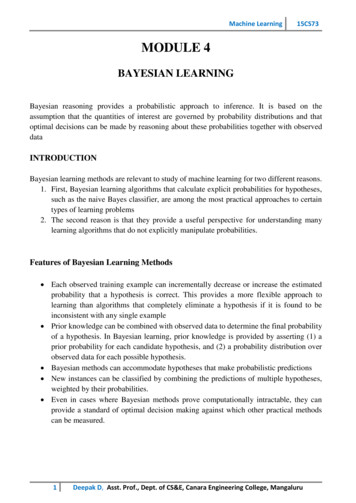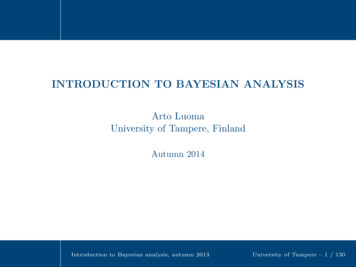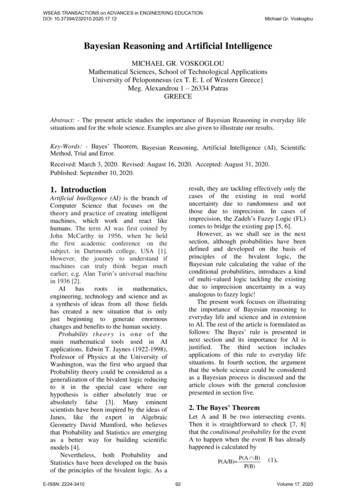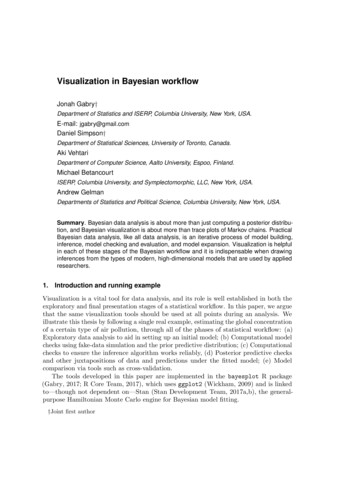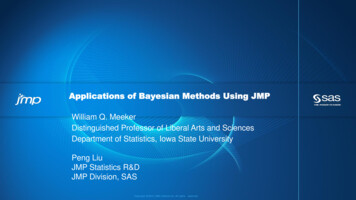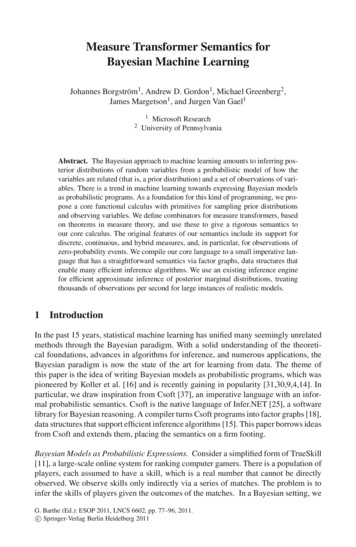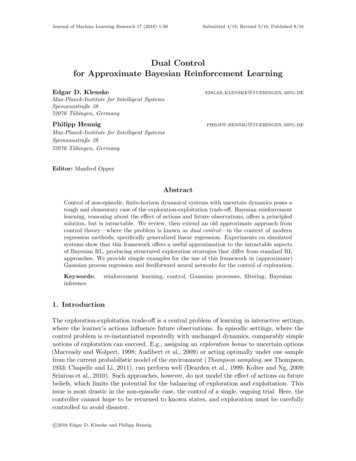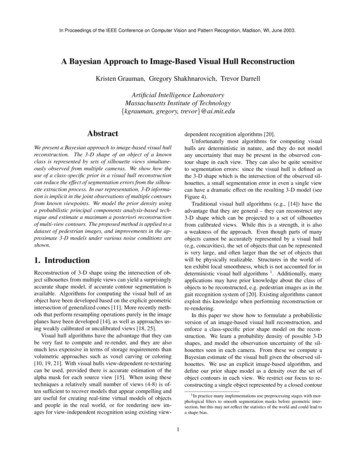
Transcription
In Proceedings of the IEEE Conference on Computer Vision and Pattern Recognition, Madison, WI, June 2003.A Bayesian Approach to Image-Based Visual Hull ReconstructionKristen Grauman, Gregory Shakhnarovich, Trevor DarrellArtificial Intelligence LaboratoryMassachusetts Institute of Technology{kgrauman, gregory, trevor}@ai.mit.eduAbstractdependent recognition algorithms [20].Unfortunately most algorithms for computing visualhulls are deterministic in nature, and they do not modelany uncertainty that may be present in the observed contour shape in each view. They can also be quite sensitiveto segmentation errors: since the visual hull is defined asthe 3-D shape which is the intersection of the observed silhouettes, a small segmentation error in even a single viewcan have a dramatic effect on the resulting 3-D model (seeFigure 4).Traditional visual hull algorithms (e.g., [14]) have theadvantage that they are general – they can reconstruct any3-D shape which can be projected to a set of silhouettesfrom calibrated views. While this is a strength, it is alsoa weakness of the approach. Even though parts of manyobjects cannot be accurately represented by a visual hull(e.g, concavities), the set of objects that can be representedis very large, and often larger than the set of objects thatwill be physically realizable. Structures in the world often exhibit local smoothness, which is not accounted for indeterministic visual hull algorithms 1 . Additionally, manyapplications may have prior knowledge about the class ofobjects to be reconstructed, e.g. pedestrian images as in thegait recognition system of [20]. Existing algorithms cannotexploit this knowledge when performing reconstruction orre-rendering.In this paper we show how to formulate a probabilisticversion of an image-based visual hull reconstruction, andenforce a class-specific prior shape model on the reconstruction. We learn a probability density of possible 3-Dshapes, and model the observation uncertainty of the silhouettes seen in each camera. From these we compute aBayesian estimate of the visual hull given the observed silhouettes. We use an explicit image-based algorithm, anddefine our prior shape model as a density over the set ofobject contours in each view. We restrict our focus to reconstructing a single object represented by a closed contourWe present a Bayesian approach to image-based visual hullreconstruction. The 3-D shape of an object of a knownclass is represented by sets of silhouette views simultaneously observed from multiple cameras. We show how theuse of a class-specific prior in a visual hull reconstructioncan reduce the effect of segmentation errors from the silhouette extraction process. In our representation, 3-D information is implicit in the joint observations of multiple contoursfrom known viewpoints. We model the prior density usinga probabilistic principal components analysis-based technique and estimate a maximum a posteriori reconstructionof multi-view contours. The proposed method is applied to adataset of pedestrian images, and improvements in the approximate 3-D models under various noise conditions areshown.1. IntroductionReconstruction of 3-D shape using the intersection of object silhouettes from multiple views can yield a surprisinglyaccurate shape model, if accurate contour segmentation isavailable. Algorithms for computing the visual hull of anobject have been developed based on the explicit geometricintersection of generalized cones [11]. More recently methods that perform resampling operations purely in the imageplanes have been developed [14], as well as approaches using weakly calibrated or uncalibrated views [18, 25].Visual hull algorithms have the advantage that they canbe very fast to compute and re-render, and they are alsomuch less expensive in terms of storage requirements thanvolumetric approaches such as voxel carving or coloring[10, 19, 21]. With visual hulls view-dependent re-texturingcan be used, provided there is accurate estimation of thealpha mask for each source view [15]. When using thesetechniques a relatively small number of views (4-8) is often sufficient to recover models that appear compelling andare useful for creating real-time virtual models of objectsand people in the real world, or for rendering new images for view-independent recognition using existing view-1 Inpractice many implementations use preprocessing stages with morphological filters to smooth segmentation masks before geometric intersection, but this may not reflect the statistics of the world and could lead toa shape bias.1
in each view; this simplifies certain steps in contour processing and representation. It is well known that the probability densities of contour models for many object classescan be efficiently represented as linear manifolds [1, 2, 4],which can be computed using probabilistic principal component analysis (PPCA) techniques [22]. In essence, weextend this approach to the case of multiple simultaneousviews used for visual hull reconstruction.for the details of these methods.While we restrict our attention to visual hulls from calibrated cameras, recent work has shown that visual hulls canbe computed from weakly calibrated or uncalibrated views[18, 25]. Detailed models can be constructed from visualhulls with view-dependent reflectance or texture and accurate modeling of opacity [15].A traditional application of visual hulls is the creationof models for populating virtual worlds, either for detailedmodels computed offline using many views (perhaps acquired using a single camera and turntable), or for onlineacquisition of fast and approximate models for real-time interaction. Visual hulls can also be used in recognition applications. Recognition can be performed directly on 3-Dvisibility structures from the visual hull (especially appropriate for the case of orthogonal virtual views), or the visualhull can be used in conjunction with traditional 2-D recognition algorithms. In [20] a system was demonstrated whichrendered virtual views of a moving pedestrian for integratedface and gait recognition using existing 2-D recognition algorithms.In this paper we consider visual hulls constructed fromclosed contours of pedestrian images. The authors of [1]developed a single-view model of pedestrian contours, andshowed how a linear subspace model formed from principal components analysis (PCA) could represent and tracka wide range of motion [2]. The Active Shape Model of[5] used a similar technique and was successfully applied tomodel facial variation.The use of linear manifolds estimated by PCA to represent an object class, and more generally an appearancemodel, has been developed by several authors [4, 8, 23].A probabilistic interpretation of PCA-based manifolds hasbeen introduced in [6, 24] as well as in [16], where it wasapplied directly to face images. Snakes [9] and Condensation (particle filtering) [7] have also been used to exploitprior knowledge while tracking single contours.While regularization or Bayesian maximum a posteriori(MAP) estimation of single-view contours has received considerable attention as described above, relatively little attention has been given to multi-view data from several cameras simultaneously observing an object. With multi-viewdata, a probabilistic model and MAP estimate can be computed on implicit 3-D structures. In this paper we apply aPPCA-based probability model to form Bayesian estimatesof multi-view contours used for visual hull reconstruction.Figure 1: Schematic illustration of the geometry of visualhull construction (as intersection of visual cones)In the following section we review related previouswork on visual hulls and probabilistic contour models. Wethen present our model for probabilistic image-based visualhulls. Next, we show an application of this approach to thereconstruction of pedestrian images. We demonstrate thatthe Bayesian reconstructions are more accurate than reconstructions based on the raw silhouettes. We conclude with adiscussion and the avenues for future work.2. Previous workA visual hull (VH) is defined by a set of camera locations,the cameras’ internal calibration parameters, and silhouettesfrom each view. Most generally, it is the maximal volumethat creates all possible silhouettes of an object. The VH isknown to include the object, and to be included in the object’s convex hull. In practice, the VH is usually computedwith respect to a finite, often small, number of silhouettes.(See Figure 1.) One efficient technique for generating theVH computes the intersection of the viewing ray from eachdesignated viewpoint with each pixel in that viewpoint’s image [14]. A variant of this algorithm approximates the surface of the VH with a polygonal mesh [13]. See [11, 13, 14]3. Bayesian image-based visual hullsIn this work, we derive a multi-view contour density modelfor 3-D visual hull reconstruction. We represent the silhouette shapes as sampled points on closed contours, with theshape vectors for each view concatenated to form a single2
(b) Output(a) InputFigure 2: An example of VH data flow: (a) the input - a set of four images and the corresponding silhouettes; (b) the output the reconstructed 3-D model, seen here from two different viewpoints.vector in the input space. Our algorithm can be extended toa fixed number of distinguishable objects by concatenatingtheir shape vectors, and to disconnected shapes more general than those representable by a closed contour if we adoptthe level-set approach put forth in [12].As discussed above, many authors have shown that aprobabilistic contour model using PCA-based density models can be useful for tracking and recognition. An appealingly simple technique is to approximate a shape space witha linear manifold [5]. In practice, it is often difficult to represent complex articulated structures using a single linearmanifold.Following [4, 22], we construct a density model usinga mixture of Gaussians PPCA model that locally modelsclusters of data in the input space with probabilistic linearmanifolds. We model the uncertainty of a novel observationand obtain a MAP estimate for the low-dimensional coordinates of the input vector, effectively using the class-specificshape prior to restrict the range of probable reconstructions.In the following section we see that if the 3-D object canbe described by linear bases, then an image-based visualhull representation of the approximate 3-D shape of that object should also lie on a linear manifold, at least for the caseof affine cameras.can be expressed asp M aj bj BaT(1)j 1where a (a1 , .aM ) are the basis coefficients for the M3-D bases bj (bj1 , bj2 , ., bjn )T , bji is the vector with the3-D coordinate of point i in basis vector j, and B is thebasis matrix whose columns are the individual bj vectors.A matrix whose columns are a set of observed 3-D shapeswill thus have rank less than or equal to M . Note that thecoefficients a are computed for each given p.When a 3-D shape expressed as in (1) is viewed by a setof K affine cameras with projection matrices Mk , we willobtain a set of image points which can be described asck (xk1 , xk2 , ., xkn ), 1 k K,(2)wherexki Mk pi MkM j 1aj bji M j 1aj Mk bji .Therefore, ck itself belongs to a linear manifold in the setof projected bases in each camera:ck 3.1. Multi-view observation manifoldsM j 1If the vector of observed contour points of a 3-D object resides on a linear manifold, then the affine projections of thatshape also form a linear manifold. Assume we are given a3-D shape defined by the set of n points resulting from alinear combination of 3n-D basis vectors. That is, the 3n-Dshape vectorp (p1 , p2 , ., pn )Taj qjk aqk ,(3)where qjk is the projected image of 3-D basis bj in camerak:qjk (Mk bj1 , Mk bj2 , .Mk bjn )T .A matrix whose columns are a set of observed 2-D pointswill thus have rank less than or equal to M . For the construction of (1) - (3), we assume an ideal dense sampling of3
points on the surface. The equations hold for the projectionof all points on that surface, as well as for any subset ofthe points. If some points are occluded in the imaging process, or we only view a subset of the points (e.g., those onthe occluding contour of the object in each camera view),the resulting subset of points can still be expressed as in (3)with the appropriate rows deleted. The rank constraint willstill hold in this reduced matrix.It is clear from the above discussion that if the observedpoints of the underlying 3-D shape lie on an M -dimensionallinear manifold, then the concatenation of the observedpoints in each of the K viewsin the training set are projected into each of the subspacesassociated with the mixture components, and the resultingmeans μti and covariances Σti of those projected coefficientsare retained. The prior density is thus defined as a mixtureCof Gaussians, P (P) i 1 πi N (μti , Σti ).The projection y of observation on is defined as aweighted sum of the projections into each mixture component’s subspace,y P (P y o) P (o P y) P (P y).3.2. Contour likelihood and priorThus the posterior density is the mixture of Gaussians thatresults from multiplying the Gaussian likelihood and themixture of Gaussians prior:We should thus expect that when the variation in a set of 3D objects is well-approximated by a linear manifold, theirmulti-view projection will also lie on a linear manifold ofequal or lower dimension. When this is the case, we can approximate the density using PPCA with a single Gaussian.For more general object classes, object variation may onlylocally lie on a linear manifold; in these cases a mixture ofmanifolds can be used to represent the shape model [4, 22].We construct a density model using a mixture of Gaussians PPCA model that locally models clusters of data in theinput space with probabilistic linear manifolds. An observation is the concatenated vector of sampled contour pointsfrom multiple views. Each mixture component is a probability distribution over the observation space for the trueunderlying contours in the multi-view image. Parametersfor the C components are determined from the set of observed data vectors on , 1 n N , using an EM algorithmto maximize a single likelihood functionn 1logC πi p(on i)(5)where p(i on ) is the posterior probability of component igiven the observation. To account for camera noise or jitter,we model the observation likelihood as a Gaussian distribution on the manifold with mean μo y and covariance Σo :P (o P) N (μo , Σo ), where P is the shape.Applying Bayes rule, we see thatcan also be expressed as a linear combination of similarlyconcatenated projected basis views qjk . Thus an observationmatrix constructed from multiple instances of on will stillbe at most rank M .N p(i on )(Wi T (on μi )),i 1on (c1 , c2 , ., cK )TL C P (P y o) C i 1πi N (μpi , Σpi ).(6)By distributing the single Gaussian across the mixturecomponents of the prior, we see that the components of theposterior have means and covariancesΣpi (Σtiμpi Σpi Σti 1 1 tμi 1 Σ 1,o ) Σpi Σ 1o y.(7)The modes of this function are then found using a fixedpoint iteration algorithm as described in [3]. The maximumof these modes, x , corresponds to the MAP estimate, i.e.,the most likely lower-dimensional coordinates in the subspace for our observation given the prior 2 . It is backprojected into the multi-view image domain to generate the reconstructed silhouettes S. The backprojection is a weightedsum of the MAP estimate multiplied by the PCA bases fromeach mixture component of the prior:(4)i 1where p(o i) is a single component of the mixture of Gaussians PPCA model, and πi is the ith component’s mixingproportion. A separate mean vector μi , principal axes Wi ,and noise variance σi are associated with each of the Ccomponents. As this likelihood is maximized, both the appropriate partitioning of the data and the respective principal axes are determined. We used the Netlab [17] implementation of [22] to estimate the PPCA mixture model.The mixture of probabilistic linear subspaces constitutesthe prior density for the object shape. All of the imagesS C p(i x )(Wi (Wi T Wi ) 1 x μi ).(8)i 12 Note that for a single Gaussian PPCA model with prior N (µ , Σ ),ttthe MAP estimate is simply 1 1 1x Σ 1Σ 1t Σot µt Σo y .4
By characterizing which projections into the subspaceare most likely, we restrict the range of reconstructions to bemore like that present in the training set. Our regularizationparameter is Σo , the covariance of the density representingthe observation’s PCA coefficients. It controls the extent towhich the training set’s coefficients guide our estimate.With the above alignments made to the data, inputs willstill vary in two key ways: the absolute angle the pedestrian is walking across the system workspace, and the phaseof their walk cycle at that frame. Unsurprisingly, we havefound experimentally that reconstructions are poor whena single PPCA model is used and training is done withmulti-view data from all possible walking directions andmoments in gait cycle. Thus we group the inputs according to walking direction, and then associate a mixture ofGaussians PPCA model with each direction. Our visual hullsystem provides an estimate of the walking direction; however, without it we could still do image-based clustering. Anovel input is then reconstructed using MAP estimation, asdescribed in Section 3.2. In Figure 3 we show the first twomulti-view principal components recovered for one of themixture components’ linear subspaces.According to the visual hull definition, missing pixels ina silhouette from one view are interpreted as absolute evidence that all the 3-D points on the ray corresponding to thatpixel are empty, irrespective of information in other views.Thus, segmentation errors may have a dramatic impact onthe quality of the 3-D reconstruction. In order to examinehow well the reconstruction scheme we devised would handle this issue and improve 3-D visual hull approximations,we tested sets of views with segmentation errors due to erroneous foreground/background estimates. We also synthetically imposed gross errors to test how well our method canhandle dramatic undersegmentations. Visual hulls are constructed from the input views using the algorithm in [14].The visual hull models resulting from the reconstructedviews are qualitatively better than those resulting from theraw silhouettes (see Figures 4, 5). Parts of the body whichare missing in one input view do appear in the complete 3-Dapproximation. Such examples illustrate the utility of modeling the uncertainty of an observed contour. In order toquantitatively evaluate how well our algorithm eliminatessegmentation errors, we obtained ground truth segmentations for a set of the multi-view pedestrian silhouettes bymanually segmenting the foreground body in each view. Werandomly selected 15 frames from our test set to examinein this capacity. The mean squared error per contour pointfor the raw silhouettes in our ground truthed test set wasfound to be approximately 30 pixels, versus 11 pixels forthe reconstructed silhouettes. This analysis is preliminarybut promising.4. Reconstruction of pedestrian imagesWe have applied our method to the dataset of pedestriansequences used in [20]. The images consist of four monocular views from cameras located at approximately the sameheight about 45 degrees apart. The working space of thesystem is defined as the intersection of their fields of view,and a simple color background model allows the extractionof a silhouette from each viewpoint. The use of a basicbackground subtraction method results in rough segmentation; body parts are frequently truncated in the silhouettes where the background is not highly textured, or elseparts are inaccurately distended due to common segmentation problems from shadows or other effects. (See Figure 2for example images from the experimental setup.)The goal is to improve segmentation in the multi-viewframes by reconstructing problematic test silhouettes basedon MAP estimates of their projections into the mixture oflower dimensionsional subspaces (see Section 3.1 and 3.2).The subspaces are derived from a separate, cleaner subsetof the silhouettes in the dataset. When segmentation improvements are made jointly across views, we can expect tosee an improvement in the 3-D approximation constructedby the visual hull.We represent each view’s silhouette as sampled pointsalong the closed contour extracted from the original binaryimages. All contour points are normalized to a commontranslation and scale invariant input coordinate system asfollows. First, each image coordinate of the contour points(x, y) is transformed to the coordinates (xr , yr ), in order tomake points relative to an origin placed at that silhouette’scentroid (xc , yc ).(xr , yr ) (x xc , y yc ).Next, points are normalized by d, the median distance between the centroid and all the points on the contour:(xn , yn ) (xr /d, yr /d).5. ConclusionsFinally, each view’s vector of contour points is resampled to a common vector length using nearest neighbor interpolation. Empirically, resample sizes around 200 pointswere found to be sufficient to represent contours originating from (240 x 320) images and containing on average 850points. The concatenation of the K views’ vectors formsthe final input.We have developed a Bayesian approach to visual hull reconstruction using an image-based representation of objectshape. We show how the use of a class-specific prior invisual hull reconstruction reduces the effect of segmentation errors in the silhouette extraction process. In our repre5
1110.5000 1 2 0.5 1 0.500.5 1 10 2 0.511110.50.50.5000 0.5 0.5 0.5 1 0.501 10.5 0.50 10.5 0.511110.50.50.50000 0.5 0.5 0.5 0.5 10.5 0.50 1 0.50.510 10 20.5 0.510.50010.50 2 0.5 0.50 10.5 0.500.50.50.5000 0.5 0.5 0.501000 1 101 2 0.50 2 0.50.5(a) The first principal component 10.5 0.50.5 1 2 1010 1 10.5 0.51 1 0.50.5101 10.5 0.5010.50.500 0.50 10.5 0.51 10.5 0.510 10 10.5 0.500.500.500.510 10 20.5 0.510 1 0.50 20.5 0.50 20.5 0.5(b) The second principal componentFigure 3: Primary modes of variation for the multi-view contours. The columns correspond to the four views. The middlerow shows the mean contour for each view. The top and the bottom show the result of negative and positive variation along(a) the first and (b) the second principal component for one component of the mixture of PPCA model. The positive andnegative variations are proportional to the largest and smallest PCA coefficients present in the training set, respectively.sentation, 3-D information is implicit in the joint observation of multiple contours from known viewpoints. We usea mixture of probabilistic principal components analyzersto model the multi-view contour prior density. Our methodwas applied to a dataset of pedestrian sequences, and improvements in the approximate 3-D models under variousnoise conditions were shown. We plan to further test ourmethod to see if our model improves accuracy in applications that use a visual hull for view synthesis in recognition tasks. We will also consider extensions to the proposedshape model that would allow the inference of 3-D structure.Vision Conference, pages 33–42, York, England, September1994.[7] M. Isard and A. Blake. Condensation – conditional density propagation for visual tracking. International Journalof Computer Vision, 29(1):5–28, 1998.[8] M. Jones and T. Poggio. Multidimensional morphable models. In Proceedings IEEE Conf. on Computer Vision and Pattern Recognition, pages 683–688, New Delhi, January 1998.[9] M. Kass, A. Witkin, and D. Terzopoulos. Snakes: Activeshape models. International Journal of Computer Vision,1(4):321–331, 1988.[10] K. Kutulakos and S. Seitz. A theory of shape by space carving. In Proceedings of the 7th IEEE International Conference on Computer Vision, pages 307–314, Los Alamitos,CA, September 1999.References[11] A. Laurentini. The visual hull concept for silhouette-basedimage understanding. IEEE Transactions on Pattern Analysis and Machine Intelligence, 16(2):150–162, February1994.[1] A. Baumberg and D. Hogg. Learning flexible models fromimage sequences. In Proceedings of European Conferenceon Computer Vision, 1994.[2] A. Baumberg and D. Hogg. An adaptive eigenshape model.In British Machine Vision Conference, pages 87–96, Birmingham, September 1995.[12] M. Leventon, W. E. L. G. Grimson, and O. Faugeras. Statistical shape influence in geodesic active contours. In Proceedings IEEE Conf. on Computer Vision and Pattern Recognition, pages 316–323, Hilton Head Island, SC, June 2000.[3] M. Carreira-Perpinan. Mode-finding for mixtures of Gaussian distributions. IEEE Transactions on Pattern Analysis and Machine Intelligence, 22(11):1318–1323, November2000.[13] W. Matusik, C. Buehler, and L. McMillan. Polyhedral visualhulls for real-time rendering. In Proceedings of EGWR-2001,pages 115–125, London, England, June 2001.[4] T. Cootes and C. Taylor. A mixture model for representingshape variation. In British Machine Vision Conference, 1997.[14] W. Matusik, C. Buehler, R. Raskar, S. Gortler, and L. McMillan. Image-based visual hulls. In Kurt Akeley, editor, Siggraph 2000, Computer Graphics Proceedings, Annual Conference Series, pages 369–374. ACM Press / ACM SIGGRAPH / Addison Wesley Longman, 2000.[5] T. F. Cootes, C. J. Taylor, D. H. Cooper, and J. Graham.Active shape models - their training and application. Computer Vision and Image Understanding, 61(1):38–59, January 1995.[15] W. Matusik, H. Pfister, A. Ngan, P. Beardsley, R. Ziegler, andL. McMillan. Image-based 3D photography using opacityhulls. In Proceedings of the 29th Conference on Computer[6] J. Haslam, C. Taylor, and T. Cootes. A probabilistic fitnessmeasure for deformable template models. In British Machine6
Figure 4: An example of segmentation improvement with PPCA-based Bayesian reconstruction. The four top-left imagesshow the multi-view input, corrupted by segmentation noise. The four images directly to their right show the correspondingBayesian reconstructions. The visual hull (VH) model is shown under the silhouettes from which it was constructed, for boththe raw input (left) and the reconstructed silhouettes (right). Finally, virtual frontal and profile views projected from the VHsare shown at the bottom. Note how the right arm is missing in the virtual frontal view produced by the raw VH (bottom,leftmost image), whereas the arm is present in the Bayesian reconstructed version (bottom, image second from right).Graphics and Interactive Techniques, ACM Transactions onGraphics, pages 427–437, New York, July 2002.[18] E. Boyer S. Lazebnik and J. Ponce. On computing exactvisual hulls of solids bounded by smooth surfaces. In Proceedings IEEE Conf. on Computer Vision and Pattern Recognition, pages 156–161, Lihue, HI, December 2001.[16] B. Moghaddam. Principal manifolds and probabilistic subspaces for visual recognition. IEEE Transactions on PatternAnalysis and Machine Intelligence, 24(6):780–788, June2002.[19] S. Seitz and C. Dyer. Photorealistic scene reconstruction byvoxel coloring. In Proceedings IEEE Conf. on Computer Vision and Pattern Recognition, pages 1067– 1073, San Juan,[17] Netlab. http://www.ncrg.aston.ac.uk/netlab/index.html.7
Figure 5: Another example of segmentation improvement with PPCA-based reconstruction. Please refer to the caption ofFigure 4 for explanation.Puerto Rico, June 1997.482, 1999.[23] M. A. Turk and A. P. Pentland. Face recognition using eigenfaces. In Proceedings IEEE Conf. on Computer Vision andPattern Recognition, pages 586–590, Hawai, June 1992.[20] G. Shakhnarovich, L. Lee, and T. Darrell. Integrated Faceand Gait Recognition From Multiple Views. In ProceedingsIEEE Conf. on Computer Vision and Pattern Recognition, Lihue, HI, December 2001.[24] Y. Wang and L. H. Staib. Boundary finding with prior shapeand smoothness models. IEEE Transactions on Pattern Analysis and Machine Intelligence, 22(7):738–743, 2000.[21] D. Snow, P. Viola, and R. Zabih. Exact voxel occupancywith graph cuts. In Proceedings IEEE Conf. on ComputerVision and Pattern Recognition, pages 345–353, Hilton HeadIsland, SC, June 2000.[25] K. Wong and R. Cipolla. Structure and motion from silhouettes. In Proceedings of the International Conference onComputer Vision, pages 217–222, Los Alamitos, CA, July2001.[22] M. Tipping and C. Bishop. Mixtures of probabilistic principal component analyzers. Neural Computation, 11(2):443–8
A Bayesian Approach to Image-Based Visual Hull Reconstruction Kristen Grauman, Gregory Shakhnarovich, Trevor Darrell Artificial Intelligence Laboratory Massachusetts Institute of Technology {kgrauman, gregory, trevor}@ai.mit.edu Abstract We present a Bayesian approach to image-based visual hull reconstruction. The 3-D shape of an object of a known
